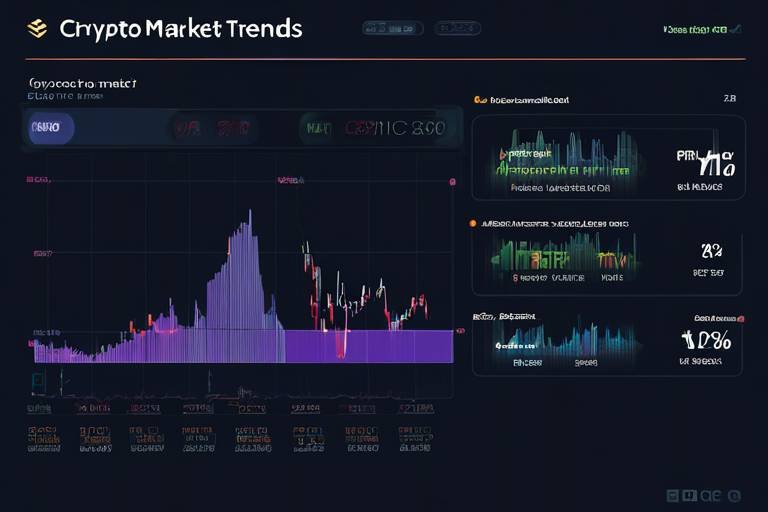How to Spot Investment Opportunities
In today's fast-paced financial landscape, the ability to spot investment opportunities can be the difference between success and failure. Whether you're a seasoned investor or just starting out, understanding the nuances of various markets is essential. But how do you identify these golden opportunities? It all begins with a keen eye for detail and a willingness to dig deeper into the factors that influence market behavior.
First and foremost, it's important to recognize that investment opportunities are often hidden beneath the surface. Just like a treasure hunter sifting through sand, you need to be equipped with the right tools and knowledge to uncover valuable prospects. This article will guide you through effective strategies and techniques that can help you navigate the complex world of investing. Are you ready to discover the secrets that can lead you to lucrative investments? Let’s dive in!
Recognizing market trends is crucial for spotting investment opportunities. Market trends can be likened to the waves of the ocean; they ebb and flow, sometimes gently and other times with great force. Understanding these movements requires an analysis of various economic indicators such as GDP growth, unemployment rates, and consumer confidence. By closely monitoring these indicators, you can gain insights into when to enter or exit a market.
For instance, a rising GDP coupled with decreasing unemployment rates typically signals a robust economy, creating fertile ground for investment opportunities. Conversely, a declining trend may suggest caution. So, how do you keep track of these trends? Utilizing financial news platforms, subscribing to economic reports, or even following market analysts on social media can provide you with valuable information that keeps you ahead of the curve.
Financial statements are like the health reports of a company; they reveal critical insights into its performance. By learning to interpret balance sheets, income statements, and cash flow statements, you can identify potential investments that align with your financial goals. For example, a company with a strong balance sheet may indicate stability, while a robust income statement can reflect profitability.
To further refine your analysis, financial ratios serve as essential tools for evaluation. They can simplify complex data into easily digestible insights. Here are some of the most important ratios:
| Ratio | Description |
|---|---|
| P/E Ratio | Price-to-Earnings ratio indicates how much investors are willing to pay for $1 of earnings. |
| ROI | Return on Investment measures the gain or loss generated relative to the investment cost. |
Profitability ratios assess a company's ability to generate earnings relative to its revenue, assets, or equity. Metrics like the net profit margin and return on equity (ROE) can signal strong investment opportunities. A company with a high net profit margin indicates efficient management and pricing strategies, making it a potential candidate for investment.
Liquidity ratios measure a company's ability to meet short-term obligations. Understanding these ratios helps investors evaluate the financial health of potential investments. The current ratio and quick ratio are key indicators here. A company with a current ratio above 1 is generally considered financially stable, as it indicates that it can cover its short-term liabilities with its short-term assets.
Growth metrics indicate a company's potential for future expansion. Revenue growth and market share are two significant factors that investors should consider. A company showing consistent revenue growth often signals its ability to innovate and capture market share, making it an attractive investment opportunity.
Different industries have varying growth potentials, and evaluating these can be the key to spotting lucrative investment opportunities. For instance, technology and healthcare sectors are often seen as high-growth areas due to their continuous innovation and demand. On the other hand, traditional industries may offer stability but might lack the explosive growth potential that investors seek.
Emerging markets often present unique investment opportunities. These markets can be volatile, but they also hold the potential for high returns. Factors to consider when investing in developing economies include political stability, economic reforms, and demographic trends. The allure of tapping into a growing middle class can be irresistible for savvy investors.
Technological advancements can create new markets and disrupt existing ones. Keeping an eye on tech trends can help you spot investment opportunities in innovative sectors. For example, advancements in artificial intelligence and renewable energy are paving the way for new investment avenues. Staying updated on these trends can position you ahead of the curve.
Building relationships and conducting thorough research are vital for discovering investment opportunities. Networking with industry professionals can provide insights that you won't find in reports. Attend conferences, join investment clubs, and engage in online forums to expand your knowledge and connections. Remember, the more you know, the better your investment decisions will be.
- What are the best ways to analyze financial statements? - Focus on key metrics such as profitability and liquidity ratios, and consider trends over time.
- How can I identify emerging markets? - Look for countries with growing economies, increasing foreign investment, and a rising middle class.
- Why is networking important in investing? - Networking can provide you with insider knowledge and access to opportunities that may not be publicly available.

Understanding Market Trends
Recognizing market trends is crucial for spotting investment opportunities. Think of the market as a vast ocean—sometimes calm, sometimes stormy. Understanding the waves, currents, and tides can help you navigate toward profitable shores. In this section, we will dive into how to analyze market movements and economic indicators, allowing you to make informed investment choices. The first step is to understand that market trends can be broadly categorized into three types: uptrends, downtrends, and sideways trends.
Uptrends indicate a general increase in prices over time, suggesting a bullish market where investors are optimistic. Conversely, downtrends show a decline in prices, signaling a bearish market filled with caution and uncertainty. Sideways trends can be tricky, as they represent a period of indecision in the market, where prices fluctuate within a narrow range. To effectively spot these trends, you can use various tools and techniques, such as:
- Technical Analysis: This involves studying price charts and patterns to predict future movements. Tools like moving averages, trend lines, and candlestick patterns can be invaluable.
- Fundamental Analysis: This approach focuses on understanding the underlying factors that influence market behavior, such as economic indicators, interest rates, and corporate earnings.
- Sentiment Analysis: Gauging the mood of the market can help you predict future movements. Are investors feeling bullish or bearish? This can be assessed through surveys, news articles, and social media sentiment.
One of the most effective ways to gauge market trends is by analyzing economic indicators. These indicators can provide insights into the overall health of the economy and can include:
| Indicator | Description |
|---|---|
| Gross Domestic Product (GDP) | A measure of economic activity that indicates the overall health of the economy. |
| Unemployment Rate | The percentage of the labor force that is unemployed and actively seeking employment. |
| Consumer Price Index (CPI) | A measure of the average change over time in the prices paid by consumers for goods and services. |
| Interest Rates | The cost of borrowing money, which can influence consumer spending and investment. |
By keeping an eye on these indicators, you can better understand the economic landscape and identify potential investment opportunities. For instance, if the GDP is rising and unemployment is falling, it may indicate a thriving economy, which could lead to increased consumer spending and, subsequently, higher stock prices.
Additionally, consider the importance of market cycles. Markets typically go through cycles of expansion and contraction, much like the seasons of the year. Recognizing where we are in the cycle can help you make more strategic investment decisions. For example, investing during the expansion phase can yield higher returns as companies grow and profits increase.
In conclusion, understanding market trends requires a blend of analytical skills, awareness of economic indicators, and a keen sense of timing. By mastering these elements, you can position yourself to take advantage of lucrative investment opportunities as they arise. So, are you ready to ride the waves of the market and discover your next big investment?

Analyzing Financial Statements
When it comes to investing, one of the most powerful tools at your disposal is the analysis of financial statements. These documents provide a detailed snapshot of a company's financial health and performance, allowing you to make informed decisions. Think of financial statements as the report card for a business; they reveal how well the company is doing and whether it’s a worthy investment. The three main types of financial statements you’ll encounter are the balance sheet, income statement, and cash flow statement. Each one serves a unique purpose and offers different insights.
The balance sheet gives you a look at what a company owns (assets) versus what it owes (liabilities). This is crucial for understanding a company's net worth and financial stability. Imagine you’re considering buying a used car; you’d want to know how much it’s worth compared to any debt it may have, right? Similarly, a balance sheet helps you gauge whether a company is financially sound.
Next up is the income statement, which details a company's revenues and expenses over a specific period. This statement is vital for assessing profitability. It tells you whether the company is making money or losing it. Picture this: if you were running a lemonade stand, the income statement would show you how much you made from selling lemonade versus how much you spent on lemons and sugar. The bottom line, or net income, is what you ultimately want to focus on here.
Lastly, we have the cash flow statement, which tracks the flow of cash in and out of the business. This is essential because a company can be profitable on paper but still run into trouble if it doesn’t have enough cash to cover its obligations. Think of it as your monthly budget; you might have a good income, but if you’re spending more than you earn, you’re in trouble.
To make sense of these statements, investors often rely on financial ratios. Ratios help you compare different aspects of a company's performance and can highlight potential investment opportunities. Here are some key ratios to keep an eye on:
| Ratio | Formula | What It Indicates |
|---|---|---|
| P/E Ratio (Price to Earnings) | Market Price per Share / Earnings per Share | Valuation of the company; a high ratio may indicate overvaluation. |
| ROI (Return on Investment) | (Net Profit / Cost of Investment) x 100 | Measures the efficiency of an investment. |
| Current Ratio | Current Assets / Current Liabilities | Indicates liquidity; a ratio above 1 suggests good short-term financial health. |
By analyzing these ratios, you can get a clearer picture of a company's performance. For instance, a high P/E ratio might suggest that a company's stock is overvalued, while a solid ROI indicates that an investment is performing well. These ratios can guide your investment decisions, helping you to identify which companies are worth your hard-earned money.
Profitability ratios are particularly important as they assess a company’s ability to generate earnings relative to its expenses. Metrics such as net profit margin and return on equity (ROE) are crucial here. A high net profit margin indicates that a company retains a significant portion of its revenue as profit, which is a good sign for investors. Similarly, ROE measures how effectively management is using shareholders' equity to generate profits.
Liquidity ratios, like the current ratio mentioned earlier, measure a company's ability to meet its short-term obligations. If a company has a current ratio of less than 1, it may struggle to pay its bills, which could be a red flag for investors. Understanding these ratios is essential for evaluating the financial health of potential investments, ensuring that you don’t put your money into a sinking ship.
Finally, don't overlook growth metrics. These indicators, such as revenue growth and market share, can signal a company's potential for future expansion. A company that consistently grows its revenue is likely to attract more investors and potentially offer higher returns. Just like a tree that keeps growing taller and wider, a company with strong growth metrics is one to watch closely.
- What is the most important financial statement? Each statement serves a purpose, but the income statement often provides the most immediate insight into profitability.
- How can I access financial statements? Most public companies provide their financial statements on their websites, typically in the investor relations section.
- What should I look for in a balance sheet? Focus on the company's assets versus liabilities to assess its financial health.

Key Financial Ratios
When it comes to investing, understanding financial ratios is like having a treasure map. These ratios provide crucial insights into a company's financial health and performance, guiding investors toward potentially lucrative opportunities. Think of them as the vital signs of a business; just as a doctor checks heart rates and blood pressure, savvy investors scrutinize these numbers to assess the vitality of their investments.
Among the myriad of financial ratios available, a few stand out as particularly essential. The Price-to-Earnings (P/E) ratio is one of the most commonly used metrics. It compares a company's current share price to its earnings per share (EPS). A high P/E ratio might suggest that a stock is overvalued, while a low P/E could indicate that it is undervalued. However, it’s crucial to compare a company's P/E ratio to its industry average to get a clearer picture. For instance, if a tech company has a P/E of 30 but the industry average is 20, it may be time to dig deeper.
Another vital ratio is the Return on Investment (ROI). This ratio measures the gain or loss generated relative to the investment cost. The formula is simple: ROI (Net Profit / Cost of Investment) x 100. A higher ROI percentage signifies a more profitable investment, making it a key indicator for potential investors. For example, if you invest $1,000 and earn $1,200, your ROI would be 20%. This straightforward calculation can help you compare different investment opportunities effectively.
To further illustrate the importance of these ratios, let’s take a look at a
| Company | P/E Ratio | ROI (%) |
|---|---|---|
| Tech Innovations Inc. | 25 | 30 |
| Green Energy Corp. | 15 | 20 |
In this example, Tech Innovations Inc. has a higher P/E ratio, which might suggest it’s a growth stock but also potentially overvalued. In contrast, Green Energy Corp. boasts a lower P/E but still provides a healthy ROI. This comparison highlights the importance of considering multiple ratios together rather than in isolation.
Moreover, profitability ratios like Gross Margin and Net Profit Margin can provide additional layers of understanding. The Gross Margin ratio indicates how efficiently a company is producing its goods, while the Net Profit Margin reveals how much profit a company retains after all expenses. High margins typically indicate a company’s ability to manage costs and maximize profits, making them attractive investment candidates.
In conclusion, understanding these key financial ratios equips you with the knowledge to make informed investment decisions. They serve as a compass in the vast sea of investment opportunities, helping you navigate toward those that promise the best returns. Remember, while ratios are powerful tools, they should always be used in conjunction with qualitative analysis for a well-rounded view of potential investments.

Profitability Ratios
When it comes to evaluating a company's financial health, are crucial indicators that help investors gauge how well a company is performing in terms of generating profits. These ratios provide insights into a company's ability to convert sales into actual profit, which is essential for anyone looking to make informed investment decisions. Imagine profitability ratios as the compass that guides you through the often turbulent waters of investing; they help you navigate towards opportunities that promise better returns.
There are several key profitability ratios that investors should focus on:
- Gross Profit Margin: This ratio measures the difference between revenue and the cost of goods sold (COGS), indicating how efficiently a company is producing its goods. A higher gross profit margin means more money is available to cover operating expenses and generate profits.
- Operating Profit Margin: This ratio takes into account the operating expenses and provides a clearer picture of a company's profitability from its core business operations. It’s a great way to assess how well a company is managing its operational costs.
- Net Profit Margin: This is perhaps the most comprehensive profitability ratio, as it includes all expenses, taxes, and costs. A higher net profit margin indicates a company is effectively turning revenue into actual profit.
Understanding these ratios can significantly enhance your investment strategy. For instance, if you come across a company with a consistently high net profit margin compared to its competitors, it could be a signal that the company has a competitive advantage, making it a worthwhile investment. On the flip side, a declining profit margin might suggest that the company is facing challenges that could affect its future profitability.
To illustrate these concepts, consider the following
| Company | Gross Profit Margin (%) | Operating Profit Margin (%) | Net Profit Margin (%) |
|---|---|---|---|
| Company A | 40 | 25 | 15 |
| Company B | 30 | 20 | 10 |
| Company C | 50 | 35 | 20 |
In this table, you can see how Company C outperforms the others in all three profitability ratios. This could indicate a strong market position and effective cost management, making it an attractive investment opportunity. However, it’s essential to look beyond just the numbers. Consider the industry context, market conditions, and any potential risks that could impact these ratios in the future.
In summary, profitability ratios are not just numbers; they tell a story about a company's financial health and efficiency. By understanding and analyzing these ratios, you can make more informed investment choices and potentially increase your returns in the long run.
Q: What are profitability ratios?
A: Profitability ratios are financial metrics used to assess a company's ability to generate profit relative to its revenue, expenses, or assets. They help investors evaluate a company's financial performance.
Q: Why are profitability ratios important?
A: These ratios are crucial for investors as they provide insights into a company's operational efficiency, financial health, and potential for future growth, helping to identify lucrative investment opportunities.
Q: How do I calculate profitability ratios?
A: Profitability ratios can be calculated using specific formulas. For example, the net profit margin is calculated by dividing net income by total revenue and multiplying by 100 to get a percentage.
Q: Can profitability ratios vary by industry?
A: Yes, profitability ratios can differ significantly across industries due to varying business models, cost structures, and market conditions. It’s essential to compare ratios within the same industry for a meaningful analysis.

Liquidity Ratios
When it comes to investing, understanding a company's financial health is akin to checking the pulse of a patient before surgery. One of the most critical aspects of this evaluation is through . These ratios measure a company's ability to meet its short-term obligations, ensuring that it can cover its debts without straining its operations. In essence, liquidity ratios provide a snapshot of a company's financial flexibility and operational efficiency.
The two primary liquidity ratios that investors should be aware of are the current ratio and the quick ratio. The current ratio is calculated by dividing a company's current assets by its current liabilities. This ratio gives investors an idea of whether the company can pay off its short-term debts using its short-term assets. A current ratio of less than 1 might raise a red flag, indicating potential liquidity issues, while a ratio above 1 suggests a healthy buffer.
| Liquidity Ratio | Formula | Interpretation |
|---|---|---|
| Current Ratio | Current Assets / Current Liabilities | Indicates if a company can cover short-term obligations; >1 is generally favorable. |
| Quick Ratio | (Current Assets - Inventory) / Current Liabilities | Measures immediate liquidity without relying on inventory; >1 is ideal. |
The quick ratio, on the other hand, takes it a step further by excluding inventory from current assets, focusing instead on the most liquid assets. This is particularly useful for companies where inventory turnover is slow. A quick ratio greater than 1 indicates that a company can comfortably meet its short-term liabilities without relying on inventory sales, which can sometimes be unpredictable.
In addition to these ratios, investors should also consider the cash ratio, which is the most conservative measure of liquidity. This ratio is calculated by dividing cash and cash equivalents by current liabilities. It provides a clear picture of a company's ability to pay off its short-term obligations using only its most liquid assets. A high cash ratio is a sign that the company is well-prepared for any financial surprises.
Understanding liquidity ratios is crucial when evaluating potential investments. They not only help you gauge a company's financial stability but also provide insight into how effectively it manages its resources. For instance, a company with strong liquidity ratios may be better positioned to invest in growth opportunities, pay dividends, or weather economic downturns. On the flip side, a company struggling with liquidity may face challenges that could impact its stock performance and, ultimately, your investment returns.
In conclusion, liquidity ratios are essential tools for any investor looking to make informed decisions. They serve as a financial health check, revealing how well a company can handle its short-term debts. By keeping an eye on these ratios, you can better navigate the investment landscape and identify opportunities that align with your financial goals.

Growth Metrics
When diving into the world of investments, understanding is like having a treasure map. These metrics act as signposts, pointing you toward companies that have the potential for future expansion and profitability. One of the most critical growth metrics to consider is revenue growth. Imagine a river flowing steadily; a company with increasing revenue is like that river, gaining strength and width as it moves forward. This consistent increase in revenue often indicates that the company is effectively reaching its market and expanding its customer base.
Another vital growth metric is market share. Think of market share as the slice of the pie that a company owns in its industry. A growing market share suggests that a company is not just surviving but thriving—often at the expense of its competitors. If a company is consistently increasing its market share, it’s a strong signal that it’s doing something right, whether through innovative products, superior customer service, or effective marketing strategies.
To illustrate the importance of these metrics, let's take a look at a simple
| Company | Revenue Growth (Year-on-Year) | Market Share (%) |
|---|---|---|
| Company A | 15% | 25% |
| Company B | 8% | 10% |
In this example, Company A is clearly outperforming Company B in both revenue growth and market share. This suggests that Company A is not only expanding its operations but is also becoming more dominant in its industry, making it a more attractive investment opportunity.
However, it’s essential to look beyond just these two metrics. Other factors, such as customer retention rates and the ability to adapt to market changes, also play a crucial role in a company's growth potential. For instance, a company that has a loyal customer base may experience steadier growth compared to one that relies heavily on new customer acquisition. Therefore, when evaluating growth metrics, consider the broader picture and how these indicators interact with each other.
In conclusion, growth metrics are invaluable tools for investors. By understanding and analyzing these indicators, you can uncover promising investment opportunities that might otherwise go unnoticed. Just remember, while growth metrics provide essential insights, they should be part of a more extensive analysis that includes other financial and qualitative factors to ensure you're making the most informed investment decisions.
- What are growth metrics? Growth metrics are indicators that help assess a company's potential for future expansion, such as revenue growth and market share.
- Why are growth metrics important for investors? They help investors identify companies that are likely to perform well in the future, guiding them toward lucrative investment opportunities.
- How do I calculate revenue growth? Revenue growth can be calculated by taking the current period's revenue, subtracting the previous period's revenue, and then dividing that number by the previous period's revenue, finally multiplying by 100 to get a percentage.

Evaluating Industry Potential
When it comes to investing, understanding the potential of different industries is like having a treasure map. Each industry can be compared to a unique landscape, where some areas are brimming with opportunities while others might be barren. To navigate this terrain effectively, you need to evaluate various factors that contribute to an industry's growth potential. It’s not just about picking the hottest trend; it’s about making informed decisions based on solid analysis.
One of the first steps in evaluating industry potential is to analyze market trends. This involves looking at historical data, current performance, and future projections. For instance, if you notice that an industry has consistently shown growth over the past few years, it might be a sign that it’s worth your attention. Additionally, keeping an eye on economic indicators like GDP growth, unemployment rates, and consumer spending can provide valuable insights into the overall health of an industry.
Another critical aspect is understanding the competitive landscape. Who are the major players in the industry? What is their market share? Analyzing the competition helps you gauge how saturated the market is and where there might be opportunities for new entrants or innovative products. For instance, if a few companies dominate an industry, it may be challenging for newcomers to gain a foothold. Conversely, if the market is fragmented, there could be room for growth and innovation.
Furthermore, consider the regulatory environment. Different industries are subject to varying degrees of regulation, which can significantly impact their growth potential. For example, the healthcare industry often faces stricter regulations compared to technology sectors. Understanding these regulations can help you identify potential risks and opportunities within an industry.
To illustrate these points, let’s take a look at a comparative analysis of three different industries:
| Industry | Growth Rate (2023) | Major Players | Regulatory Challenges |
|---|---|---|---|
| Technology | 15% | Apple, Google, Microsoft | Moderate |
| Healthcare | 10% | Pfizer, Johnson & Johnson | High |
| Renewable Energy | 20% | NextEra Energy, First Solar | Low |
As you can see from the table, the renewable energy sector is not only growing at a rapid pace but also faces fewer regulatory challenges compared to healthcare. This makes it an attractive industry for investors looking for long-term opportunities. However, it’s essential to do your homework and analyze what’s driving this growth—whether it’s technological advancements, government incentives, or a shift in consumer preferences.
Lastly, always keep an eye on emerging trends within industries. For example, the rise of artificial intelligence and machine learning is reshaping multiple sectors, creating new investment opportunities. By staying updated on technological innovations and shifting consumer behaviors, you can position yourself ahead of the curve and make more informed investment choices.
- What factors should I consider when evaluating an industry?
Look at market trends, competitive landscape, regulatory environment, and emerging trends. - How can I stay updated on industry trends?
Follow industry news, subscribe to relevant newsletters, and join professional networks. - Is it necessary to analyze financial statements for industry evaluation?
Yes, understanding financial metrics can provide insights into the health and potential of companies within the industry.

Emerging Markets
Investing in is like navigating through uncharted waters—there's a mix of excitement and uncertainty. These markets, typically found in developing countries, often present unique investment opportunities that can yield high returns. However, they also come with their own set of risks. So, what makes these markets so attractive? For starters, emerging economies are generally characterized by rapid growth and industrialization. This growth can be fueled by a young population, increasing consumer demand, and expanding infrastructure.
When considering investments in emerging markets, it's essential to evaluate several factors:
- Economic Stability: Look for countries with stable governments and sound economic policies. Political unrest can lead to drastic market fluctuations.
- Market Accessibility: Ensure that the market is open to foreign investments. Some countries have restrictions that can hinder your ability to invest.
- Currency Risks: Fluctuations in local currencies can significantly impact returns. It's vital to understand the currency dynamics of the country you're investing in.
One of the most significant advantages of investing in emerging markets is the potential for exponential growth. For instance, countries like India and Brazil have shown impressive GDP growth rates, often outpacing developed nations. This growth can translate into substantial gains for investors willing to take the plunge. However, it's crucial to conduct thorough research and stay updated on local market trends and economic indicators.
To illustrate the potential of emerging markets, consider the following table that highlights some key emerging economies and their projected growth rates:
| Country | Projected GDP Growth Rate (2023) |
|---|---|
| India | 6.5% |
| Brazil | 3.5% |
| Vietnam | 6.8% |
| Nigeria | 3.2% |
In conclusion, while emerging markets offer enticing opportunities, they require a nuanced approach. Investors should arm themselves with knowledge and be prepared to adapt to the ever-changing landscape. By keeping an eye on economic indicators and conducting diligent research, you can uncover hidden gems in these dynamic markets.
Q: What are emerging markets?
A: Emerging markets are economies that are in the process of rapid growth and industrialization. They often have lower GDP per capita compared to developed countries but show significant potential for expansion.
Q: What are the risks associated with investing in emerging markets?
A: Risks include political instability, currency fluctuations, and less transparent regulatory environments. It's essential to conduct thorough research and consider these factors before investing.
Q: How can I invest in emerging markets?
A: You can invest through mutual funds, exchange-traded funds (ETFs), or directly in stocks of companies based in emerging economies. It's advisable to consult with a financial advisor to find the best approach for your investment goals.

Technological Innovations
In today's fast-paced world, are not just buzzwords; they are the driving forces behind new investment opportunities. As an investor, you must keep your finger on the pulse of the latest tech trends to identify where the next big opportunity might arise. Think of technology as a river that carves new paths through the landscape of the economy; if you know where to look, you can find fertile ground for investment.
One of the most exciting aspects of investing in technology is the sheer variety of sectors that are experiencing rapid growth. From artificial intelligence to renewable energy, the opportunities are vast. For instance, AI is not just transforming industries; it's creating entirely new ones. Companies that leverage AI for data analysis, customer service, or even product development are often poised for explosive growth. Imagine a small startup that develops an AI tool to streamline supply chain management—this could revolutionize how businesses operate, making it a juicy target for investment.
Moreover, the rise of blockchain technology has opened up a plethora of opportunities in finance, logistics, and even healthcare. As more industries begin to adopt blockchain for its transparency and security features, savvy investors can capitalize on this trend before it becomes mainstream. Just as the internet changed the way we communicate and do business, blockchain could do the same for transactions and data integrity.
To effectively spot these opportunities, it's essential to stay informed. Follow tech news, subscribe to industry reports, and engage with thought leaders on platforms like LinkedIn. Networking can often lead to insights that are not yet available in the public domain. Consider attending tech conferences or webinars where you can meet innovators and entrepreneurs who are at the forefront of these changes.
Additionally, keep an eye on venture capital trends. Many VC firms publish reports on the sectors they are investing in, which can provide valuable insights into where the smart money is going. For instance, if a significant number of venture capitalists are pouring funds into quantum computing, it may be time to explore related companies or technologies.
To summarize, technological innovations are a goldmine for investors willing to do their homework. By understanding the trends, networking with industry leaders, and keeping an eye on venture capital movements, you can position yourself to take advantage of the next wave of technological breakthroughs. Remember, in the world of investing, being proactive often pays off more than being reactive. So, gear up and get ready to dive into the world of tech investments!
- What are some key technological trends to watch for investment opportunities?
Some key trends include artificial intelligence, blockchain technology, renewable energy, and biotechnology. These sectors are constantly evolving and present lucrative opportunities for investors.
- How can I stay updated on technological innovations?
Follow tech news websites, subscribe to industry reports, attend webinars, and engage with thought leaders on social media platforms like LinkedIn.
- Why is networking important in identifying investment opportunities?
Networking can provide insights and access to opportunities that may not be widely known. Building relationships with industry experts can help you gain a competitive edge.

Networking and Research
In the world of investing, the phrase "it's not what you know, but who you know" couldn't be more accurate. Networking is an invaluable asset for any investor looking to spot lucrative opportunities. By building relationships with other investors, industry professionals, and financial advisors, you can gain insights that are often not available through traditional research methods. Imagine being at a party and overhearing a conversation about a groundbreaking technology that could revolutionize an entire industry. That’s the kind of information that can turn a good investment into a great one!
Moreover, research is a critical component of identifying potential investments. It’s essential to dive deep into the specifics of any investment opportunity. This means not just skimming the surface, but really getting to know the companies and industries you’re interested in. Utilize resources like financial news websites, industry reports, and analytical tools to gather data. The more informed you are, the better your investment decisions will be.
To effectively network and conduct research, consider the following strategies:
- Attend Industry Conferences: These events are gold mines for networking. You can meet influential people in your field and learn about emerging trends.
- Join Online Investment Forums: Platforms like Reddit or specialized investment forums allow you to connect with other investors and share insights.
- Follow Influential Investors: Keep an eye on what seasoned investors are talking about. Their insights can lead you to hidden gems.
By combining networking with thorough research, you can create a powerful strategy for identifying investment opportunities. Think of it like putting together a puzzle; each piece of information you gather adds clarity to the bigger picture. You’ll be able to see trends and opportunities that others might overlook. This dual approach not only enhances your knowledge but also builds confidence in your investment choices, allowing you to make decisions that are both informed and timely.
In conclusion, don’t underestimate the power of human connections and diligent research. They are your best tools for navigating the complex world of investments. Whether you’re a seasoned investor or just starting out, a strong network combined with solid research can lead you to opportunities that could significantly boost your portfolio.
1. Why is networking important in investing?
Networking opens doors to valuable information and insights that can lead to lucrative investment opportunities. It allows you to connect with seasoned professionals who can guide you through the complexities of the market.
2. How can I effectively research investment opportunities?
Effective research involves analyzing financial statements, understanding market trends, and keeping up-to-date with industry news. Utilize a variety of resources, including financial news websites, industry reports, and analytical tools.
3. What are some good places to network with other investors?
Consider attending industry conferences, joining online investment forums, and following influential investors on social media platforms. These venues provide great opportunities to connect and share insights.
4. Can I rely solely on online research for my investments?
While online research is crucial, it’s also important to engage with other investors and professionals. Combining online research with networking can provide a more comprehensive understanding of potential investment opportunities.
Frequently Asked Questions
- What are the best strategies for spotting investment opportunities?
Spotting investment opportunities requires a keen eye for market trends, understanding financial statements, and analyzing key financial ratios. It’s like being a detective in the world of finance—always looking for clues that hint at where the next big opportunity might lie!
- How can I analyze market trends effectively?
To analyze market trends, start by keeping an eye on economic indicators such as GDP growth, unemployment rates, and consumer spending. Utilize tools like charts and graphs to visualize changes over time. Think of it as reading the pulse of the economy—if you can sense the rhythm, you can make informed decisions!
- What key financial ratios should I focus on?
Some essential financial ratios to consider include the Price-to-Earnings (P/E) ratio, Return on Investment (ROI), and debt-to-equity ratio. These ratios help you evaluate the financial health and performance of a company. It’s like having a financial compass that guides you through the investment landscape!
- How do I interpret financial statements?
Interpreting financial statements involves looking at the balance sheet, income statement, and cash flow statement. Each document tells a part of the story about a company's performance. It’s like piecing together a puzzle—each piece gives you insight into the bigger picture of the company’s financial health!
- What should I consider when evaluating industry potential?
When evaluating industry potential, consider factors like market demand, competition, and technological advancements. Look for industries that are experiencing growth or are projected to expand. It’s akin to watching the tides; some industries will rise while others may fall, so knowing which way to surf is crucial!
- Are emerging markets worth the investment?
Yes, emerging markets can offer unique investment opportunities due to their potential for high growth. However, they also come with risks. It’s like venturing into uncharted waters—there’s treasure to be found, but you need to navigate carefully to avoid pitfalls!
- How important is networking in finding investment opportunities?
Networking is incredibly important as it can open doors to valuable information and insights. Building relationships with other investors, industry experts, and financial advisors can help you uncover hidden gems in the market. Think of it as building your own treasure map—connections can lead you to the richest finds!
- What role do technological innovations play in investments?
Technological innovations can create entirely new markets and investment opportunities. Staying updated on tech trends helps you identify sectors poised for growth. It’s like having a crystal ball that reveals the future—those who can spot the next big thing often reap the biggest rewards!



















